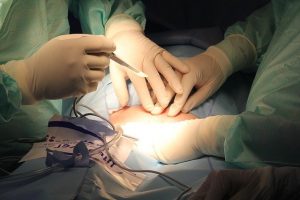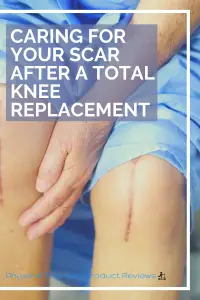After a lot of anxiety and preparation, your surgery is finally done. You’re on the road to recovery. You’ve started healing on the inside, but now what are you going to do about the unsightly scar that has been left behind? How do you eliminate or reduce a scar after surgery?

Some people consider their scars to be their ‘battle wounds and wear them with pride. However, many people want to eliminate or significantly reduce post-surgical scarring as much as possible. Many creams and therapies offer to do just that.
Scar Tissue - How it Forms
When you’re injured or have surgery, the inflammatory system tries to heal the injured area. The inflammatory system removes the damaged tissues and cells so the injury can begin to heal. Some of the new cells that are formed are made up of collagen.

Scar tissue forms when collagen cells do not arrange themselves properly due to the disruption of the tissue from surgery. They clump together, resulting in scar tissue. Fortunately, there are ways to eliminate or significantly reduce the scar tissue that has formed.
Caring for Your Post Surgical Scar
Once your incision has sealed itself and you can get it wet and wash it regularly, you can start trying to eliminate or reduce the appearance of your post-surgical scar. There are many ways to support your body in the healing process.
Using Massage and Topical Treatments
One of the best ways to help eliminate or reduce your post-surgical scarring is to gently massage the incision site multiple times per day. In the beginning, this will be tender and slightly uncomfortable. The more you do it, the uncomfortable it will feel and the faster it will heal.

Massaging your scar is so effective because it helps to break down the scar tissue and promotes blood flow to the area, helping return to its natural state. It’s also recommended that you use some form of topical cream or ointment in conjunction with massage.
Using a topical treatment in combination with massage turbo-charges the healing process. Massage your scar with your fingers or use alternatives, such as a firm ball or marble, to help break up the scar tissue. Do what feels comfortable to you.
If you experience extreme sensitivity while massaging, you can desensitize the scar by gently rubbing it with different materials daily. Start with soft, smooth fabrics and work your way up to more texture as you heal.
Other Tips for Expediting the Healing Process
The real key to healing well is having overall good health. If you’ve been slacking and are not exactly where you want to be that’s okay. It’s never too late to get into shape and live a healthy life.
Proper Nutrition
Eating the proper foods boosts your immune system and promotes healing.
- Eat lots of fruits and vegetables that are high in antioxidants combined with proteins and healthy fats for all-around balanced nutrition.
- Avoid foods that are high in carbohydrates and sugar.
Maintaining a healthy weight is good for your overall health and reduces the stress on your joints and surgery sites.
Keep Your Scar out of Direct Sunlight
Use sunscreen or lotion with an SPF to keep from getting burned. Mederma also offers a scar removal gel that includes an SPF for sun protection.
No Smoking
Quit smoking before surgery and during recovery because smoking reduces blood flow and circulation by restricting oxygen to the organs and tissues.

Manage Other Health Issues
If you suffer from a chronic illness, such as diabetes, it’s important to stay on top of it. If your numbers are out of whack, your body won’t be working at its optimum level and will not heal as well.
Get Some Sleep
Don’t underestimate the power of sleep. Getting enough rest is essential to the healing process. Sleep is the time when your body heals the most. So do what you need to do to get those Z’s.
Look out for Keloid Scars
Some people are more prone to getting what is called keloid scars resulting in lumpy raised scar sites. If you are one of the many people affected by this condition there is the option of having your doctor perform steroid injections into the scar site.
Injections will help to keep the tissue supple and promote healing. There are also manual and electronic massagers that help to break up the scar tissue and speed up the recovery process.
Other Factors that Affect Healing Times
When you have surgery, take into consideration that everyone heals differently and at a different pace. Don’t be discouraged because your neighbor had a double knee replacement and is back to her old shenanigans in a shorter time than you are from your single knee operation.
Be patient when going through the healing process. Sometimes it can take up to a full year for your scar to fully go away and heal. The following factors can affect the way you heal:
- Age
- Genetics
- Overall Health
- Race
Caring for You Scar
Scar Helping Products to Promote Faster Healing
Aroamas™ Scar Removal Sheets
These silicone strips should be worn for a minimum of four hours per day and a maximum of twelve hours. You can start using these strips around seven days after surgery and immediately on old scars. You will typically start to see desired results within twelve weeks.
Alternative option: There is also a gel version of this product. It works the same way as the strips. However, you need to apply it two or three times daily and rub it in for several minutes to be sure it is absorbed properly. This is also good if you have a scar that is visible and you don’t want to have a plastic strip for everyone to see.
Boao™ Facial Ridgid Roller Kit
Get the most bang for your buck! This amazing kit offers multiple options for you to break that scar tissue up with. You are not limited to using this on just your scars, you can use it all over your body to promote better circulation and skin elasticity.
Mederma™ Advanced Scar Gel
Clinically proven to reduce the visibility of scars from surgery, acne, and other injuries. Apply once daily. You will be very pleased with the results. This cream works on old and new scars.
Cost-saving tip: If you are on a tight budget or if it seems insane to pay, there are generic alternatives available at your local pharmacy or big-box stores. Be sure to look for the active ingredient Allium cepa. These alternatives are still not cheap; however, you can probably save yourself around $5.00 – $10.00 by going with this route.
Nature’s Bounty™ Vitamin E Oil
Using Vitamin E on scars has been practiced for years. It has not been proven to reduce the appearance of scars, but it does keep the scar moist and supple while you are massaging the scar tissue.
TYMO™ Handheld Massager
This handy little massager is a great option for breaking up that stubborn scar tissue. Not only do you get rid of that scar tissue but you can use this massager anywhere on your body that needs to be relaxed. It is lightweight, handheld, and rechargeable. It offers the option of heat and multiple head styles.
FAQ About Scar Tissue
What Does Scar tissue Feel Like?
Scar tissue feels like hard tissue and sometimes like nodules underneath the surface of the skin. Often times scar is not mobile but firm and harder than surrounding tissue.
Can Biodegradable Stitches Poke Through the Scar?
Absolutely. We have had to pull out stitches that were supposed to be biodegradable. Look out for clear stitches poking out of scar tissue as it heals.
Is Scar Tissue Bad?
Nope, in fact, scar tissue is actually good. Scar tissue is firm and stable to help protect an injury or surgical area. It’s incredibly strong! It’s only bad if it forms out of control or doesn’t begin to loosen up over time.
Does Scar Tissue Hurt?
It can and often does hurt when you press on it. This is especially true early in the healing process. The sensitivity to touch does improve as it begins to heal.
Healing Happens with Healthy Living
Getting the proper amount of rest, eating right, and following your doctor and therapist’s directions are key to the healing process. By following the helpful recommendations in this guide you are sure to eliminate or greatly reduce the appearance of your post-surgical scar.
Sources:
(https://www.dupagemedicalgroup.com/health-topic/8-ways-to-reduce-scar-formation-increase-mobility),
(https://www.verywellhealth.com/preventing-or-minimizing-scars-after-surgery-3156926),
Other Great Rehab Related Articles
GLP Weight Loss and Back Health: Effective Strategies and Insights
How to Stay Active After Cervical Fractures: Expert Tips and Advice
Dealing with Painful Stairs After Ankle Replacement Surgery
Walking After a Total Ankle Replacement: Tips for a Successful Recovery
Exercises While Non-Weight Bearing After Ankle Replacement: Elevation, AROM, Leg Raises, and More
Ankle Pain with Stairs: Causes and Home Treatment Options
Disclaimer: The information provided in this post is for educational purposes only. This is not a substitute for a medical appointment. Please refer to your physician before starting any exercise program.









